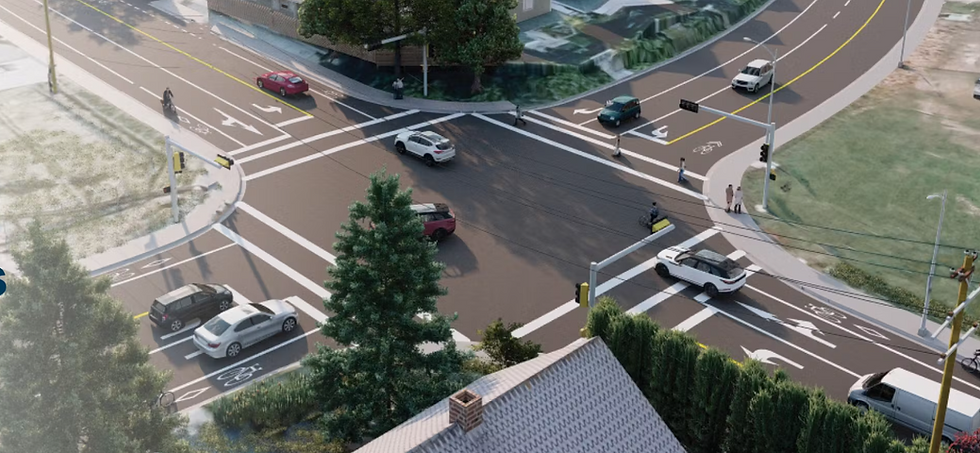Shannon Lake Road Safety - Why Multi-use Pathways
- thomasjamesgroat
- Jul 9, 2023
- 4 min read
Updated: Jul 11, 2023
Multi-use pathways are off-street pathways that are physically separated from motor vehicle traffic and can be used by any non- motorized user. This includes people walking, cycling, skateboarding, kick scootering, in-line skating, and using other active modes.

Multi-use pathways can be installed within or adjacent to different types of rights-of-way and are generally found adjacent to arterial roads and highways.
Guiding Principles
The following guiding principles should be considered when planning and designing active transportation facilities:
Safe and Stress Free - Mitigating both real and perceived safety concerns is a crucial step in attracting active transportation users.
Inclusive - Consider the needs of users of all ages and abilities.
Cohesive and Direct - should fit within a cohesive network that provides direct access to destinations such as commercial areas, employment areas, residential areas, and community amenities.
Attractive and Intuitive - should be comfortable and pleasant for people of all ages and abilities as well as recognizable, predictable, and consistent.

Benefits
Multi-use pathways provide critical benefits for all active transportation users:
· Physical separation from motor vehicle traffic.
· Appropriate for all ages and abilities.
· Appealing to families and less experienced cyclists.
· Attract tourists by providing long-distance route to or within community.
· Provide continuous and direct routes without stops or jogs.
· Helps reduce motor vehicle trips and greenhouse gas emissions.
· Encourages an active lifestyle through daily exercise.
· Reduce the risk of collisions and create a safer transportation system for all road users.
· Helps with climate change mitigation.

Multi-use pathways that follow roadway corridors are an attractive option as they provide the same benefits of a direct route offered by on-street motor vehicles, while providing a high level of comfort for users.
Multi-use pathways should be considered when the following conditions apply:
There is sufficient right-of-way width.
The pathway will be separated from all motor vehicle traffic.
There is a limited number of crossings (such as intersections, alleyways, and driveways).
Pathway continuity can be provided.
The pathway can be terminated at each end of the corridor onto roads or other pathways.
If a multi-use pathway is located within a residential neighbourhood context, separating all active transportation users from other users is recommended.
Recommended Width
Because multi-use pathways attract a variety of users, providing sufficient space to pass others is an important design consideration. A multi-use pathway on only one side of the road is appropriate if it is physically impossible to provide a facility on both sides.

Typical Applications
Multi-use pathways are most appropriate on roads with higher motor vehicle volumes and speeds, and relatively few laneways and driveways. Multi-use pathways are the preferred design treatment where motor vehicle speeds are posted at 50 km/h and motor vehicle volumes are greater than 4,000 vehicles per day.
A recent study found that cities with protected multi-use pathways had 44% fewer deaths and 50% fewer serious injuries than the average city. Furthermore, the study found that painted bicycle lanes provided no road safety improvements, and that shared use lanes were less safe than having no pavement markings at all. (Marshall and Ferenchak, ‘Why Cities with High Bicycling Rates are Safe for All Road Users’ (2019).
Coordination with Infrastructure Upgrades
Major road improvements are proposed for Shannon Lake Road. This provides an opportunity to coordinate the construction of multi-use pathways but still stay within the road right-of-way.

Project Planning and Design
Engaging with residents on the planning and design of active transportation facilities is a critical component. One way of elevating public support is by providing opportunities for community members to interact with and assess the impacts of new potential designs.
Neighbourhood excitement and support is gained when residents can anticipate improved:
Connectivity - Enabling them to travel to their destinations safely and easily.
Completeness - Letting them travel virtually anywhere they need to go by active means.
Directness - Not requiring them to go out of their way to safely access their destination.
Comfort - Providing equitable, convenient use by appealing to all residents, commuters, and visitors.
Facility Selection Consideration
The final facility selection decision should be coordinated through the experience and judgement exercised by design professionals in consultation with the community.
Motor Vehicle Speed and Volume - One of the biggest factors influencing the use of active modes of transportation is motor vehicle speed and volume.
Road Width - The most cost-effective facilities in retrofit situations are implementable within the available road width and do not require any road widening.
Users - Active transportation facilities should be universally accessible, accommodating the full spectrum of potential users with all levels of experience.
On-Street Motor Vehicle Parking - On-street parking can negatively impact cycling safety due to the potential for motor vehicle doors opening into the bike lane or the potential for motor vehicles to pull in or out of a parking space.
Retrofit Strategies
Retrofitting existing roads to add multi-use pathways can be a challenge. When considering facility retrofits, design professionals should apply sound professional judgement and should reference the TAC Geometric Design Guide for Canadian Roads, the MOTI B.C. Supplement to TAC Geometric Design Guide and any other applicable local, provincial, or national design standards to ensure that retrofits continue to meet minimum standards.
To implement more active transportation facilities, it is imperative that design professionals consider justifications and metrics beyond traditional engineering standards.
These considerations could include questions such as:
Does the facility provide a link with other facilities?
Would the addition of the facility create a safer environment for vulnerable road users?
Does the facility increase universal accessibility?
Does the facility provide an improved active transportation connection along a main corridor within the community or link important destinations?
Does the facility fit into the strategic plan for the community?




Comments